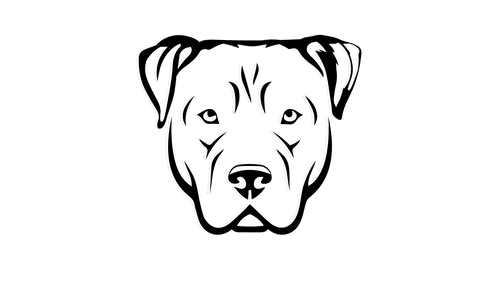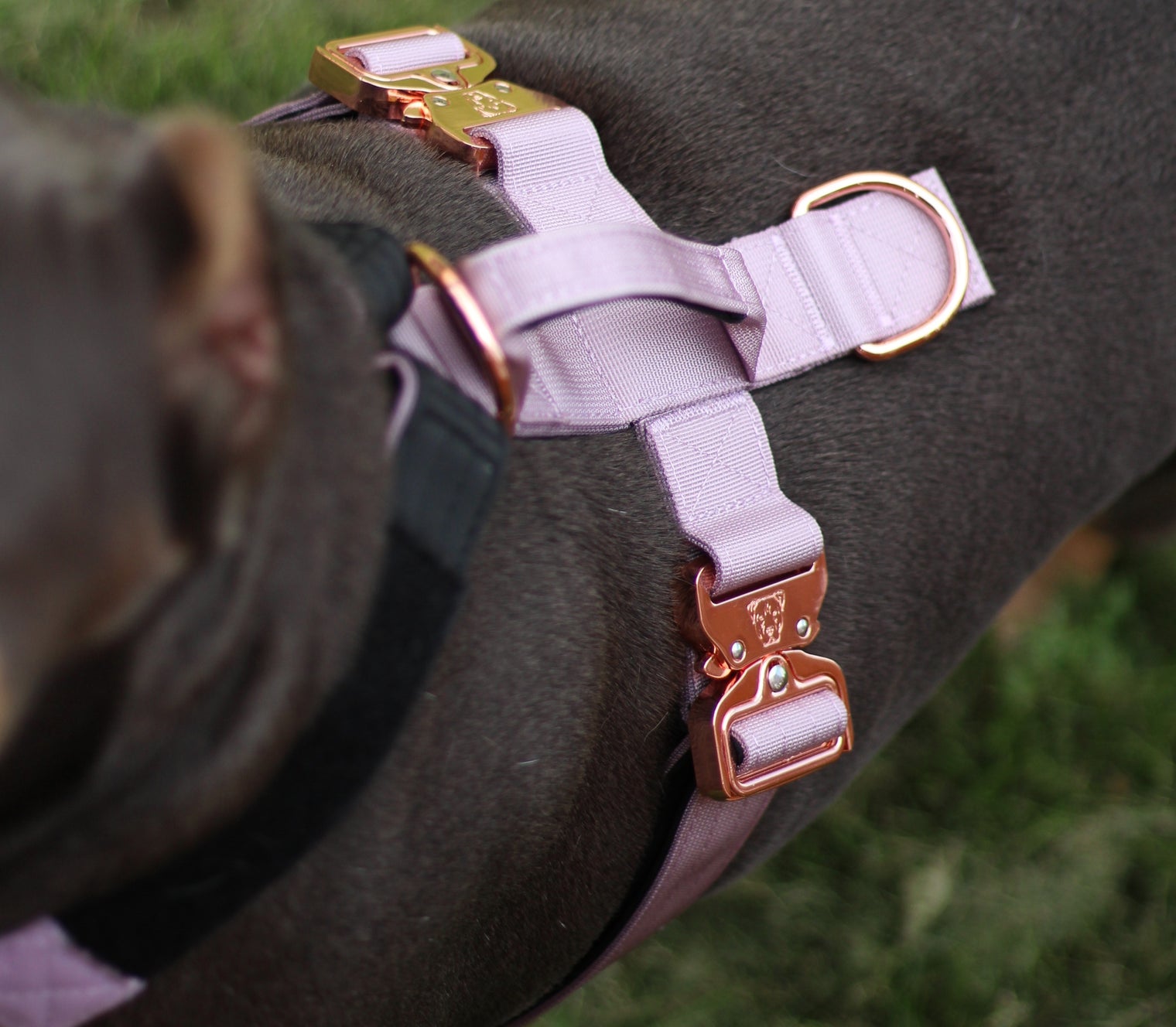Staffies are affectionate dogs that develop amazingly close bonds with their owners. Although this sounds good, it comes with risks. These dogs are assertive and protective and are willing to go the extra mile to protect their owners. Staffies won’t shy from biting any person or animal they think is a threat to their owner.
It’s no wonder these dogs are considered aggressive and are even banned in some provinces like Ontario. The best you can do to live a peaceful and trouble-free life with your Stafford is to get a harness that will give you control over his movements. Here’s everything you need to know about a good harness for a Stafford.
The Ultimate Guide to Choosing the Best Harness for Your Staffy

Staffies are one of the five dog breeds that make up the Pitbull family. That means it’s one of the dogs bred for the vicious bull-baiting and dog-fighting games. In fact, many people confuse Staffordshire Bull Terriers with American Staffordshire Terriers and Bull Terriers.
Like other pitbull dog breeds, Staffies have a strong prey drive, with little to no tolerance for strangers and other pets. Another thing is that Staffies are born athletes with muscular bodies. So, expect a significant pulling power when they are determined to chase something.
Now, the combination of the Staffy’s massive pulling power, agility, speed, prey drive, and protectiveness is a recipe for disaster if you can’t keep him under control. For example, if you’re on a walk, the dog spots a stranger, pulls on a leash, escapes from the collar or harness, and bites the stranger.
Well, you’ll have to part with around $30,000 to $35,000, which is the average compensation for dog bites in Canada. But why fall into this hot soup in the first place—is the issue preventable? Yes! The secret is getting a harness tailored for muscular and aggressive dogs. But before we give you our ultimate recommendation, let’s first see the key features to look for in a Staffy’s harness.
Durability
Staffies are notorious chewers, and their jaws and teeth are strong enough to tear fabrics. Their muscular and athletic bodies also means they can easily break harnesses. So, when choosing a harness, you need to make sure it can withstand the heavy pulling, and the fabric can withstand chewing.
We recommend going for harnesses with reinforcements around the attachment points. It’s also advisable to go for harnesses made of nylon webbing instead of leather. The webbing is sturdy and durable, and doesn’t smell like cattle hide. That means the dog won’t find much fun chewing it.
Comfort
Walks and hikes should be fun and enjoyable for both of you. It makes no sense to take your furry friend for walks in an uncomfortable harness that’ll make him hate the whole experience. In fact, Staffords are intelligent, and they can easily remember that a harness is uncomfortable and resist wearing it the next time.
Another thing is that Staffies are short-haired. That means they get less protection from their fur compared to fluffy dog breeds such as the Great Pyrenees. It’s like the harness is sitting directly on the skin. So, when choosing a harness, make sure it has paddings for added comfort.
Fit
Fit and comfort are closely related. When the harness is too tight, it’ll rub the fur and cause bald spots. On the other hand, if it’s too large, it will move from side to side, causing rubbing and irritations. Remember that dogs lose and gain weight just like humans.
So, it’s advisable to go for harnesses with adjustable straps. That way, the harness will fit even after weight gain or loss. But don’t worry about the perfect fit. We have listed the sizing and fitting steps at the bottom of this guide.
Control Features
As we mentioned, the whole point of getting a harness is to get control over your furry friend. So, the more control features a harness has, the better. We recommend a harness that has a back clip, a front clip, and a top handle. That way, if the dog is untrained and pulls on a leash, you use the front clip.
If the dog is well-behaved, you use the back clip to give the dog more freedom. The top handle is like a safety valve. It allows you to seize immediate control when using the back clip. For instance, if you’re on walks and a strange dog pops up and your furry friend is charging to attack, you grab the top handle to gain immediate control.
Top Harness Recommendations
With all sorts of dog harnesses in the market, it’s difficult to know exactly which style and build quality suits a Stafford. Remember, there’s no one-fits-all solution to dog harnesses. The harness that works for a Yorkie won’t work for a Staffy. So, here are the top harness recommendations for a Staffy.
Noir Hunter Dog Harness

The Noir Hunter Dog Harness is our best choice, not only for a Staffy but also for any muscular dog breed or breeds that pull on a leash. That includes dogs like the Tibetan Mastiff, the Huskies, and American Bulldogs.
As we mentioned, the most important thing when dealing with a Staffy is to make sure you don’t lose control. However, nobody wants to lose control, anyway. It’s the dog pulling on a leash, and the leash or harness attachment points break, or the leash slips.
Now, the Noir Hunter Dog Harness deals with this challenge in a whole different way. It comes with front and back attachment points. When the dog pulls with the leash attached to the front clip, the harness redirects the pulling force back to you.
Essentially, the harness changes to a no-pull harness. If the Staffy is well-trained and he doesn’t pull on a leash, you just use the back clip to give him some freedom to explore and sniff scents on the trails during hikes.
In short, the Noir Hunter Dog Harness ticks all the boxes in terms of functionality, durability, and control features. But that comes at a price. You’ll have to dig a little deeper in your pocket.
Camo Hunter Dog Harness

The Camo Hunter Dog Harness is another great option for the Staffies. This harness comes with a camo color, which makes it look like a military harness. The harness is made from strong nylon webbing, so no worries if your Stafford is a heavy puller. He won't break this webbing.
All the pressure points in this webbing are reinforced. The attachment points are machine-welded, and won't snap. In short, this is one of the harnesses that allow you to walk with your furry friend without worries of escaping.
Another great thing is that all sides are adjustable. That means you can easily get a perfect fit for your furry friend as long as you go for the medium size.
The only thing you might not like about this harness is that you have several buckles to deal with. If you are taking your furry friend for regular, short walks, you'll find the buckles to be a little time-consuming.
Chocolate Hunter Dog Harness

Chocolate Hunter Dog Harness is another high-quality dog harness that can withstand even the heaviest pullers, just like the above options. As the name suggests, this harness comes in a chocolate color. This color compliments the rich, warm-toned coats of the Staffy for a classic and timeless appeal.
Remember, Staffords have short and smooth coats. That means the rough texture of the nylon webbing can easily rub the dog's skin and cause chaffing, irritations, and discomfort. But you don't have to worry about this when dealing with the Chocolate Hunter Dog Harness.
This harness comes lined with neoprene, the comfortable material used to make swimsuits. So, your dog won't have irritations even if it has sensitive skin. The main issue with this harness is that it's more bulky compared to harness styles such as the over-the-head.
Tattoo Terrain Dog Harness

As the name suggests, the Tattoo Terrain Dog Harness is an all-terrain harness that works on all occasions, unless you're leash training your companion, and you need the above no-pull harnesses. This harness is basically tailored for recreational activities like tracking, walks and hiking.
The harness is more lightweight than the above harnesses, and your furry friend can wear it all day long without exhaustion. The design is over-the-head, with few buckles and clips to deal with. This design makes the harness a great option if you are on a tight schedule and you only take the dog for walks for a few minutes in the early mornings and late evenings.
The only issue is that Staffords are naturally territorial and dominating. If he is not well-trained, he might consider the harness passing over his head as a threat.
Desert Camo Terrain Dog Harness

The Desert Camo Terrain Dog Harness is another harness that will give your furry friend a military look, just like the Camo Hunter Dog Harness. The harness comes with a neoprene lining, so there's no worry of irritations and chafing.
Another great feature is that this harness is adjustable around the stomach, chest, and shoulders. That means the harness will perfectly fit your Stafford, even if he loses or gains weight.
However, note that Staffies are medium -sized, and so go for the medium size. Other sizes won't work, even if the harness is adjustable. This harness comes with a hidden pocket where you can keep an Apple Airtag.
How to Properly Fit a Harness on Your Staffy
First things first—make sure you've got the right size. The best way to do this is to measure the chest size of your furry friend. Then, order a harness that gives room for sizing up and down.
For instance, if your Staffy's chest girth measures 26 inches, order a medium harness measuring 24-34 inches. All in all, the average chest size of Staffies is around 22-28 inches. Once you get the right size, use the following steps to fit the harness.
- A normal harness has a clip at the top where the leash goes. This should be facing upwards. However, the no-pull harnesses have this clip around the chest area. The Hunter Harnesses we recommended above have two clips. The side of the harness with the Velcro backing should be facing up.
- Place the harness over your Staffy's head. Don't tighten the harness straps yet.
- Lift the chest piece so that it touches the belly and chest area.
- Tighten the straps. Remember that the harness should be snug but not tight. Use the two-finger rule to make sure the harness is not too tight or too loose.
You don't want to start a walk only to discover your furry friend has wiggled free or he's unable to walk. Although the above steps outline the steps for fitting a harness on your dog the right way, here are some signs that can help you know something isn't alright.
- The dog is unable to walk freely
- The dog can wiggle free from the harness
- Signs of chafing and rubbing around the chest area
- The dog resists wearing it. But keep in mind that this is not a sure way to judge whether the harness is comfortable or not, as Staffies can be stubborn and refuse to wear harnesses.
Conclusion
Considering that Staffies are muscular, athletic and over protective, you must make sure the harness is sturdy and has features that give you immediate control over the dog, such as the top handle. Also, Staffies are short-haired, and the harness should have paddings to prevent rubbing, bare spots and irritations.

